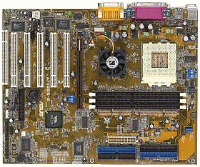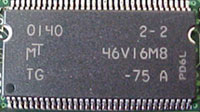Motherboard: Asus A7V266-E
 Asus
have a reputation for making very good performing motherboards and components. So it
is no surprising to see the Asus A7V266-E as the backbone of the XP 2000+ system.
The A7V266-E is based on the KT266A chipset and supports PC2100 DDRAM - a
mainstay of today's Athlon solutions - among several other substantial
feature sets. The mainboard has three DIMMS, five PCI slots, one AGP, and one ACR
slot.
Asus
have a reputation for making very good performing motherboards and components. So it
is no surprising to see the Asus A7V266-E as the backbone of the XP 2000+ system.
The A7V266-E is based on the KT266A chipset and supports PC2100 DDRAM - a
mainstay of today's Athlon solutions - among several other substantial
feature sets. The mainboard has three DIMMS, five PCI slots, one AGP, and one ACR
slot.
Of the most noteable on the board is a C-Media CMI8738 audio
controller which provides up to 6-Channels of on board audio - something that
complements the 16X DVD drive (Pioneer DVD-500M) in the XP 2000+ system perfectly. Naturally, purists
will want to drop in a full-fledged sound card to get the most possible
out of the system.
The A7V266-E board also features RAID 0 which
basically makes one big drive out of two smaller drives. What RAID 0 does is
increase data transfer by about twice and decreases latency by about half (when
implemented). It's especially useful for people who do a lot of streaming media,
as it will give them a very fast hard drive sub system. However, RAID 0 is really
not a RAID at all because there is no data redundancy. If one of the drives
fails, all data can be lost.
Chipset: VIA KT266A
The VIA Apollo KT266A chipset builds upon the earlier
KT266 chipset and features tighter timings and deeper queues designed to
increase memory and system bus performance. The KT266A chipset supports up to 4GB of PC1600 or PC2100
DDR memory along with 200/266MHz FSB Athlon and Duron processors. Additionally,
the KT266A chipset provides native support for 4X AGP, ATA 33/66/100, six USB
ports and comes with integrated 6 channel AC-97 Audio, Modem, and networking
(though not often utilized).
The 552-pin BGA chip is accompanied by the VIA VT8233
south bridge and forms the basis for many of today's more performance oriented
motherboards.
Videocard:
Asus
V8200T5/64MB
The video card is a Asus V8200T5/64MB (GF3Ti500) which is
stellar for gaming. For really intensive workstation applications there are
other video cards better suited - like the Quadro DCC we mentioned earlier.
Still, if you can't afford to spend the extra money on a card of
that caliber, the GeForce3 Ti500 is a good as any place to start
off.
Memory: Corsair PC2400 DDR (CM64SD256-2400C2)
|
Corsair have generally been regarded with good
thoughts around here, so it was good to see that 512MB worth of PC2400 DDR was included in the system. Two
256MB sticks of CAS2 PC2400 DDR (Corsair XMS2400) to be exact.
The Micron chips are model 46V16M8-75A and this should make for a very
good memory subsystem even though the Asus A7V266-E is only 'officially'
rated for PC2100. |
|

|
- CM64SD256-2400C2
- 300MHz
- 256MB Modules (x2)
- 32Mx64
- 184 DIMM
- CAS 2.0
- Unbuffered
- 16Mx8
|
Hard Drive: IBM 40GB 7200RPM Deskstar
As the size of files continues to increase, 40GB drives
are about the minimum anyone building a new system should be looking at. The
difference in performance between drives that are 5400RPM and 7200RPM is pretty
noticeable, especially if the older drive has a lot of platters, and the 7200RPM
drive only has one or two. The 40GB IBM Deskstar used on the XP2000+ system uses
two platters with four read heads capable of 8.5ms seek times. The disk rotates at 7200RPM.
The hard drive uses a 2MB cache buffer and produces 3bels of noise
while in operation.
Network Card: Allied Telesyn AT-2700TX
10/100
The Allied Telesyn 10/100 NIC is a PCI Fast Ethernet adapter. With an
auto-sensing RJ-45 port the card supports Microsoft's latest standards; ACPI,
OnNow, Magic Packet/Wake-On-LAN (WOL) and DMI. The drivers are native to Windows
XP so installation is a breeze.
DVD-ROM: Pioneer 16X DVD-ROM
(DVD-500M)
The ability to watch a DVD from your computer without
any flickering, jumping, or pixelation is necessity in this day and age. The
Pioneer DVD-ROM in the XP2000+ system is currently the fastest speed DVD drive
you can get on the market and it performed flawlessly during a test playback of
the Matrix. The general specs on the DVD-ROM drive are as follows:
-High-Speed Average Access Time: 85ms DVD-ROM, 85 ms CD-ROM
-Transfer Rate: 21,600 kB/s Max (DVD-ROM), 6000 kB/s Max (CD-ROM)
-Reads single and dual layer DVD-ROM/Video, DVD-R/RW, CD-ROM, Audio CDs,
CD-R/RW, Video CDs, Photo CDs, Hybrid CDs, CD-Extra (CD-Plus) and CD-Text Discs
-Horizontal or vertical mounting capabilities
Powersupply: Antec 400W PP-412X
A good power supply is more than just high wattage
numbers and the right amount of Molex and system power connectors. While it is important to get P4 compliant power supplies
today with a good amount of connectors for hard drives, CDROM's and other devices,
don't shop exclusively by Wattage numbers. Look for the amount of ripple
a power supply has, the lower the amount, the better quality the power supply
is generally.
| OUTPUT |
|
+5V |
-5V |
+12V |
-12V |
+3.3V |
+5V |
| Max. Load |
40.0A |
1.0A |
18.0A |
1.0A |
28.0A |
3.0A |
| Min Load |
2.0A |
0A |
0.3A |
0A |
0.3A |
0A |
| Load Reg. |
± 5% |
± 5% |
± 5% |
± 10% |
± 5% |
± 5% |
| Ripple V(p-p) |
50mV |
100mV |
120mV |
120mV |
50mV |
50mV |
